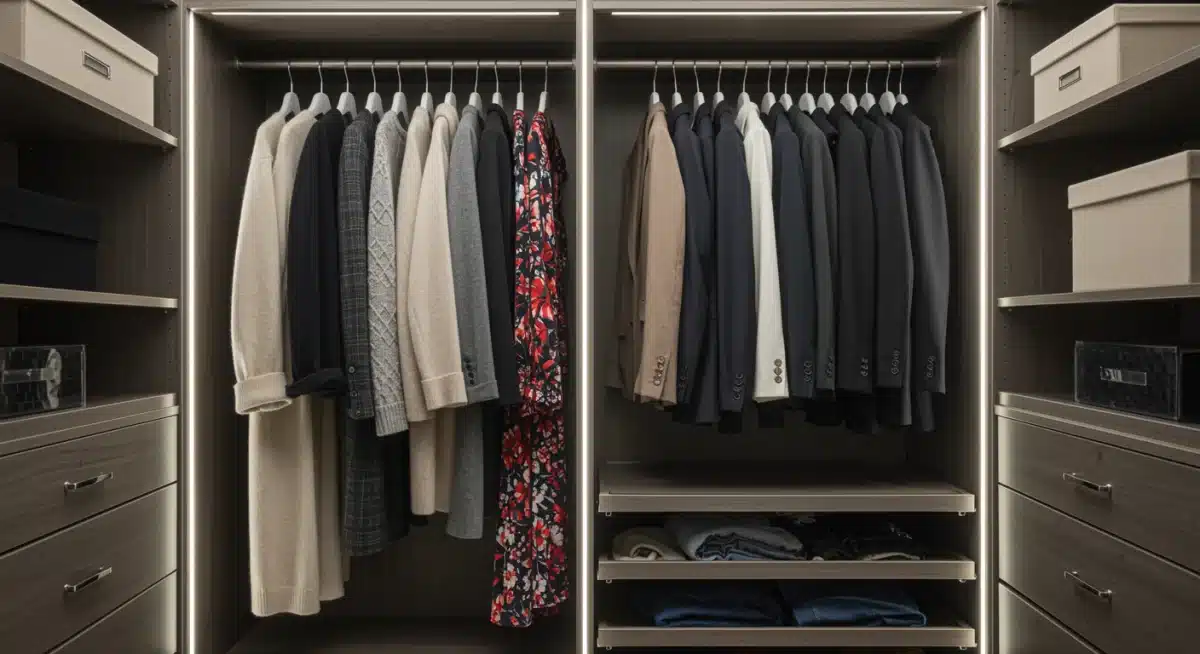Stylist Secrets: Shop Sales for Up to 70% Off

Advertisement
Professional stylists employ strategic methods to shop sales effectively, meticulously planning purchases, understanding markdown schedules, and prioritizing quality over quantity to achieve significant savings of up to 70% on desirable fashion items.
Ever wondered how some people always seem to nab the best fashion finds at incredible prices? It’s not just luck; it’s a skill. In this article, we’ll dive into the world of stylist sales secrets, revealing how professional fashion experts shop sales for the best deals, often saving up to 70% on their wardrobe investments. Get ready to transform your shopping habits and elevate your style.
The Art of Pre-Sale Preparation
Before any major sale event, the most successful shoppers – especially professional stylists – engage in meticulous preparation. This isn’t about impulse buying; it’s about strategic planning that ensures every purchase is a valuable addition to a wardrobe, not just another item clogging the closet. Understanding what you already own and what you truly need is the cornerstone of effective sale shopping.
Advertisement
Stylists often advise conducting a thorough wardrobe audit. This means going through every item you own, assessing its condition, how often you wear it, and if it still aligns with your personal style. This step helps identify gaps in your wardrobe – perhaps a classic trench coat, a versatile pair of black trousers, or a high-quality cashmere sweater. Knowing these specific needs prevents you from being swayed by tempting discounts on items you don’t truly require.
Creating a Wish List and Budget
Once you’ve identified your wardrobe gaps, the next step is to create a detailed wish list. This list should be specific, including not just the type of item but also desired brands, colors, and even fabric compositions. Having a clear vision of what you’re looking for helps you stay focused amidst the overwhelming choices during a sale.
- Prioritize Needs: Differentiate between essential items and “nice-to-haves.”
- Research Brands: Know which brands offer the quality and style you seek.
- Set Price Alerts: Many online retailers allow you to set alerts for specific items.
- Define Your Budget: A strict budget prevents overspending, even on “good deals.”
Simultaneously, establish a realistic budget for your sale shopping. This budget should be based on your financial capacity and the value you place on the items on your wish list. Remember, a deal is only a deal if it fits within your budget and serves a purpose in your wardrobe. Without proper preparation, even the steepest discounts can lead to buyer’s remorse and unnecessary clutter.
Advertisement
In essence, pre-sale preparation transforms chaotic sale shopping into a highly efficient and rewarding experience. It empowers you to make informed decisions, ensuring that every discounted item you bring home genuinely enhances your style and offers lasting value. This foundational step is what truly sets professional stylists apart in their approach to securing the best deals.
Timing is Everything: Mastering Sale Cycles
Understanding when sales happen and why is a critical component of a stylist’s arsenal. Fashion is cyclical, and so are its sales. Knowing these patterns allows you to anticipate markdowns and strike when the prices are at their lowest, maximizing your savings and securing those coveted pieces before they’re gone.
The fashion calendar largely dictates sale seasons. End-of-season sales, for instance, are prime opportunities to snag items from the current collection at significant discounts. Winter collections go on sale towards the end of winter (January/February), while summer collections see major markdowns in late summer (July/August). These are often the deepest discounts as retailers clear inventory for new arrivals.
Mid-Season and Holiday Sales
Beyond the major end-of-season clearances, there are also mid-season sales and holiday promotions. Mid-season sales, typically occurring a few months into a new collection’s release, offer moderate discounts on a wider range of items. These are excellent for picking up pieces that might not make it to the deeper end-of-season sales, especially popular sizes or colors.
- Black Friday/Cyber Monday: Unbeatable deals across almost all categories.
- Memorial Day/Labor Day: Good for transitional pieces and summer/fall essentials.
- Post-Christmas/New Year’s: Deep discounts to clear holiday inventory.
- Flash Sales: Limited-time online promotions, often requiring quick decisions.
Holiday sales, such as Black Friday, Cyber Monday, and post-Christmas sales, are universal opportunities for substantial savings. These periods see retailers aggressively discounting across all departments, making them ideal for both wardrobe staples and more trend-driven pieces. Stylists leverage these events to fill specific gaps identified during their pre-sale preparation.
Furthermore, knowing a brand’s specific markdown schedule can give you an edge. Some stores have predictable patterns, like marking down items every Tuesday or Thursday. Subscribing to newsletters and following favorite brands on social media can provide early access to sale announcements and exclusive promotions, giving you a head start before items sell out. Mastering the timing of sales is not just about saving money; it’s about strategic acquisition, ensuring you get the right items at the right price.
Quality Over Quantity: The Stylist’s Mantra
While the allure of a huge discount can be irresistible, professional stylists consistently emphasize the importance of prioritizing quality over quantity, especially during sales. A cheap garment that falls apart after a few washes or doesn’t fit well is never a true bargain, regardless of the percentage off. This principle is crucial for building a sustainable and stylish wardrobe.
When shopping sales, stylists meticulously inspect items for craftsmanship, fabric composition, and overall durability. They look for natural fibers like cotton, wool, silk, and linen, which tend to last longer and often drape better than synthetic alternatives. They also check seams, stitching, buttons, and zippers, ensuring everything is securely attached and well-finished. These details are indicators of a garment’s longevity.
Identifying Investment Pieces
Sales are an excellent opportunity to invest in higher-quality pieces that might otherwise be out of budget. Think classic trench coats, well-tailored blazers, leather goods, or cashmere sweaters. These “investment pieces” form the backbone of a versatile wardrobe and can be mixed and matched with numerous outfits, providing excellent cost-per-wear value.
- Fabric Composition: Prioritize natural fibers for durability and comfort.
- Construction: Check seams, lining, and hardware for quality.
- Fit: A good fit is paramount; alterations can add to the cost.
- Versatility: Choose items that can be styled in multiple ways.
A stylist’s eye for quality extends to understanding a garment’s potential. They consider how an item will integrate into an existing wardrobe and if it will remain stylish for seasons to come. Trends come and go, but well-made classics endure. By focusing on quality, you build a wardrobe that is not only stylish but also sustainable, reducing the need for constant replacements.
Furthermore, stylists are wary of “final sale” items unless they are absolutely certain about the purchase. The inability to return a poor-quality or ill-fitting item can negate any perceived savings. Therefore, a careful assessment of quality and fit becomes even more critical when dealing with non-returnable merchandise. Ultimately, a stylist’s mantra of quality over quantity ensures that every sale purchase is a smart, lasting addition to their client’s – or their own – wardrobe.

Strategic Online Shopping Techniques
In today’s digital age, online sales offer unparalleled opportunities for savings, but they also require a different set of strategies than in-store shopping. Professional stylists have honed their online techniques to navigate virtual racks efficiently, ensuring they snag the best deals without succumbing to digital distractions or impulsive buys.
One key strategy is to “pre-shop” online. Before a sale officially begins, many stylists add desired items to their shopping carts or wish lists. This allows them to quickly check out once the sale goes live, especially for highly sought-after items that sell out fast. It also provides a clear overview of potential purchases, helping to avoid scattered buying.
Leveraging Filters and Alerts
Online retailers offer powerful filtering tools that can significantly streamline your search. Stylists use these filters extensively to narrow down options by size, color, brand, price range, and even specific garment types. This precision saves time and helps them focus solely on items that meet their criteria.
- Size Filtering: Always filter by your specific size to avoid disappointment.
- Price Range: Set a maximum price to stay within budget.
- Brand Specificity: Target preferred brands for quality and fit consistency.
- New Arrivals on Sale: Look for recently added sale items for fresh finds.
Beyond filters, subscribing to email newsletters from your favorite brands and retailers is non-negotiable. These newsletters often announce sales before they go public, provide exclusive discount codes, or offer early access for subscribers. Additionally, many websites allow you to set up price drop alerts for specific items, notifying you as soon as a desired piece goes on sale or is further discounted.
Another smart online tactic is to cross-reference prices. Just because an item is on sale at one retailer doesn’t mean it’s the absolute best price. Stylists often check multiple sites, including department stores, brand-specific websites, and even luxury consignment platforms, to ensure they’re getting the most competitive deal. Being a savvy online shopper means being informed, patient, and strategic in your approach to maximize those digital savings.
The Art of the Try-On and Alteration
Even with the deepest discounts, a garment’s value is diminished if it doesn’t fit well or flatter the wearer. Professional stylists understand that the “perfect fit” is paramount, and they factor in the potential for alterations even when shopping sales. A well-fitting garment, even if purchased at a discount, looks far more expensive and sophisticated than a poorly fitting designer piece.
When trying on sale items, stylists don’t just look at the size tag; they assess the garment’s actual fit on the body. They pay attention to how the shoulders sit, the length of sleeves and hems, and how the fabric drapes. Often, sale racks might only have limited sizes, but if an item is slightly larger in a way that can be easily altered (e.g., taking in a waist, shortening a hem), it can still be a valuable find.
Understanding Alteration Potential and Cost
Stylists have a keen eye for what can and cannot be easily altered. Simple alterations like hemming pants, taking in a waist, or adjusting sleeve length are usually straightforward and relatively inexpensive. More complex alterations, such as reshaping shoulders or completely redesigning a garment, can be costly and might negate the savings from the sale.
- Simple Alterations: Hemming, waist adjustments, sleeve length.
- Moderate Alterations: Taking in sides, minor shoulder adjustments.
- Complex Alterations: Reshaping collars, significant structural changes.
- Factor in Cost: Always consider alteration costs when evaluating a “deal.”
It’s crucial to have a trusted tailor or seamstress who can perform these alterations. Before purchasing a sale item that requires tailoring, stylists often mentally (or even physically) calculate the alteration cost to ensure the “final price” still represents a good deal. Sometimes, a heavily discounted item might seem like a steal, but if it requires extensive and expensive alterations, it might not be worth it.
The try-on process is also an opportunity to assess the garment’s versatility. Can it be dressed up or down? Does it pair well with existing items in your wardrobe? A stylist ensures that every purchase, even a sale item, is a functional and flattering addition. By mastering the art of the try-on and understanding alteration potential, you can transform a good deal into a perfect fit, enhancing your overall style and confidence.

Post-Purchase Care and Longevity
The journey of a smart sale purchase doesn’t end at the checkout. For professional stylists, extending the life of a garment, especially one acquired at a significant discount, is crucial for maximizing its value and maintaining a high-quality wardrobe. Proper post-purchase care ensures that your “deals” remain looking their best for years to come, truly making them investment pieces.
One of the first things stylists do after acquiring a new item, particularly from a sale, is to check its care label. Different fabrics require different treatments – some are dry-clean only, others can be hand-washed, and some are machine-washable. Ignoring these instructions can lead to shrinking, fading, or damage, quickly diminishing the garment’s appeal and value.
Storage and Maintenance Tips
How you store your clothes also significantly impacts their longevity. Stylists recommend using appropriate hangers for different types of garments. Padded hangers for delicate items, sturdy wooden hangers for coats and jackets, and folding knitwear to prevent stretching are common practices. Proper storage helps maintain the garment’s shape and prevents wrinkles.
- Follow Care Labels: Always adhere to washing and drying instructions.
- Proper Hangers: Use appropriate hangers to maintain garment shape.
- Regular Maintenance: Spot clean minor stains promptly.
- Seasonal Storage: Store off-season clothes properly to protect them.
Beyond washing and storage, regular maintenance plays a vital role. This includes promptly addressing minor repairs like loose buttons or small tears, which can prevent bigger issues down the line. Spot cleaning stains immediately can save a garment from permanent damage. For delicate fabrics, investing in professional cleaning services, even if it adds to the initial cost, can significantly extend their life.
By treating your sale finds with the same care and respect you would give to full-priced luxury items, you ensure they continue to contribute positively to your wardrobe. This mindful approach to post-purchase care is an integral part of the stylist’s strategy for smart shopping, transforming temporary discounts into long-term style assets. It’s about making every dollar – saved or spent – count in the long run.
Building a Versatile and Timeless Wardrobe on a Budget
The ultimate goal of applying stylist sales secrets isn’t just to save money; it’s to build a functional, versatile, and timeless wardrobe that reflects your personal style without breaking the bank. Professional stylists are masters at curating collections that are both chic and cost-effective, proving that high fashion doesn’t always come with a high price tag if you shop smartly.
Central to this approach is focusing on “wardrobe staples” during sales. These are classic, high-quality pieces that form the foundation of countless outfits. Think well-fitting jeans, a classic white shirt, a black blazer, a neutral-colored skirt or trousers, and a versatile little black dress. These items rarely go out of style and can be dressed up or down, making them incredibly valuable additions to any wardrobe.
Mixing High-End and High-Street Finds
Stylists excel at blending high-end investment pieces (often acquired during sales) with more affordable “high-street” items. This creates a balanced and interesting aesthetic that looks polished and intentional. A designer bag or a pair of high-quality shoes can elevate an entire outfit, even if the rest of the ensemble is from a more budget-friendly retailer. Sales make those aspirational pieces attainable.
- Focus on Staples: Prioritize classic, versatile pieces first.
- Mix & Match: Ensure new items integrate with your existing wardrobe.
- Accessorize Smartly: Accessories can transform an outfit.
- Personal Style: Stay true to your aesthetic, even with trends.
Beyond staples, stylists also advise strategically incorporating trend-driven pieces, but always with an eye for longevity. A trendy top might be a fun sale purchase, but a classic cut in a trending color might offer more mileage. The key is to avoid accumulating too many fleeting trends that will quickly feel dated. Instead, use sales to experiment with new styles without a hefty financial commitment.
Ultimately, building a stylish wardrobe on a budget through sales requires discipline, vision, and a commitment to quality. By following these stylist-approved strategies – from meticulous pre-preparation and timing to focusing on quality and proper care – you can curate a wardrobe that not only serves your needs but also makes you feel confident and stylish, all while enjoying significant savings.
| Key Strategy | Brief Description |
|---|---|
| Pre-Sale Planning | Conduct wardrobe audits, create wish lists, and set budgets to avoid impulse buys. |
| Mastering Sale Cycles | Understand seasonal and holiday markdown schedules for optimal timing. |
| Quality First | Prioritize durable fabrics and good construction over fleeting trends and low prices. |
| Strategic Online Shopping | Utilize filters, wish lists, and price alerts for efficient online deal hunting. |
Frequently Asked Questions About Sales Shopping
To avoid impulse buys, create a detailed wish list based on a wardrobe audit before the sale. Stick to this list and your pre-set budget. Ask yourself if you truly need the item and if it complements your existing wardrobe. Patience and discipline are key to smart sale shopping.
The best times for significant fashion discounts are typically end-of-season sales (January/February for winter, July/August for summer) and major holiday events like Black Friday, Cyber Monday, and post-Christmas sales. These periods offer the deepest markdowns as retailers clear inventory.
Check the fabric composition for natural fibers like cotton, wool, or silk. Inspect the stitching, seams, and hardware (buttons, zippers) for durability and finish. Good quality items will feel substantial and well-constructed. Avoid synthetic blends unless they offer specific functional benefits.
Only buy a sale item that needs alterations if the alterations are minor (e.g., hemming, taking in a waist) and the combined cost of the item and alterations still represents a significant saving. Complex alterations can quickly negate the discount, so assess the potential cost carefully.
Stylists often subscribe to brand newsletters, follow retailers on social media, and use apps that track price drops. Some brands offer early access to sales for loyal customers or email subscribers. Building relationships with sales associates can also provide insider information on upcoming promotions.
Conclusion
Mastering the art of sales shopping, as demonstrated by professional stylists, is a powerful way to build a high-quality, versatile wardrobe without overspending. By embracing meticulous pre-sale preparation, understanding cyclical markdown schedules, prioritizing quality over fleeting trends, and employing strategic online techniques, anyone can unlock significant savings. Remember, the goal is not just to acquire discounted items, but to make thoughtful purchases that truly enhance your personal style and offer lasting value. With these insider secrets, you’re now equipped to shop smarter, save more, and elevate your fashion game by up to 70%.





